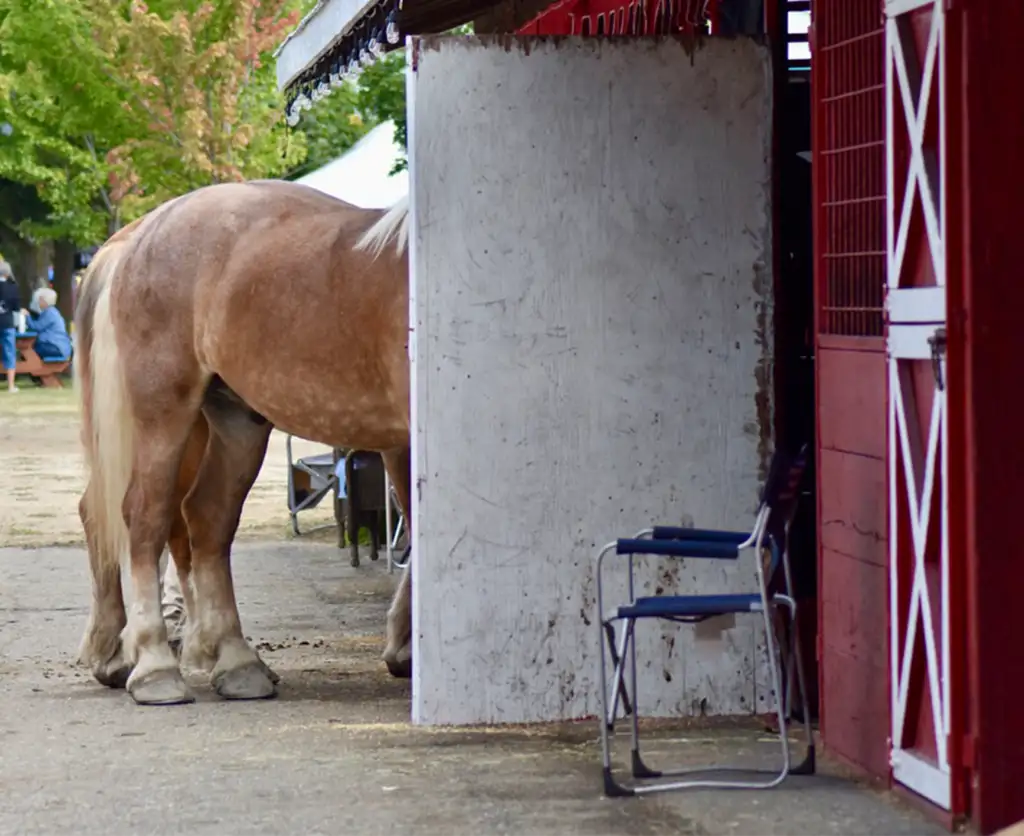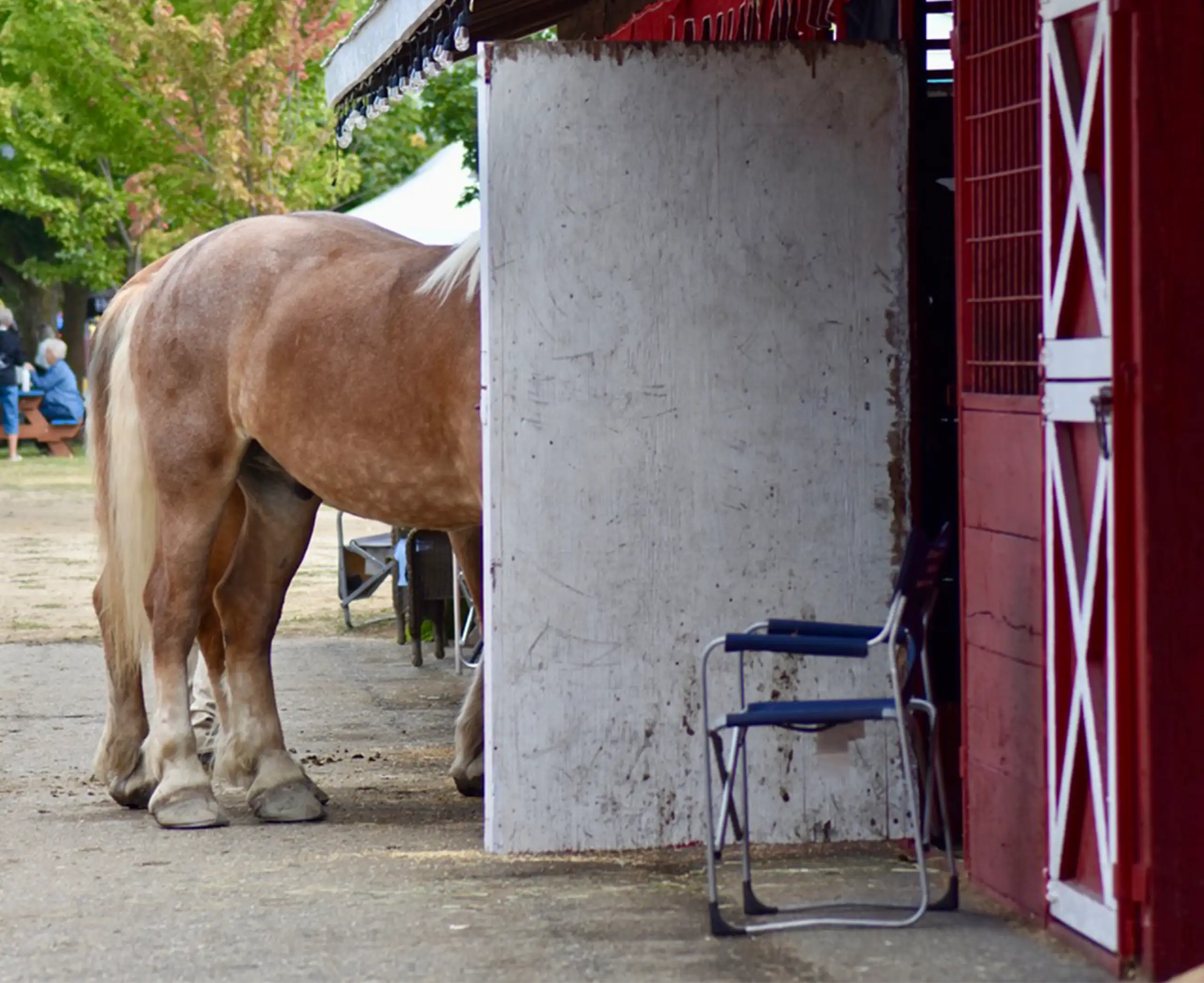The word topline is very topical these days…but it is way more than just a buzzword to throw around. For those who don’t know, the topline refers to the groups of muscles that work together to support the spine and facilitate movement. These muscles run along a horse’s neck, back, loin and croup and are a great way to indicate a horse’s athletic ability and comfort. Since the topline is such a large set of muscles, when the topline is weak or atrophied, the effects ripple throughout the entire body. From the shortening of strides to discomfort under the saddle, the topline affects every facet. In this article we’ll discuss the possible causes of topline loss, why it matters and how to help maintain it with conditioning techniques any horse can use!
As touched on above, the topline is a series of muscles that work together to help your horse lift through the back, which in turn helps them carry with balance and allows the development of impulsion from behind. A strong topline allows a horse to engage its core more effectively, absorb the rider’s weight, and move efficiently through all gaits. On the flip side, when a horse has a weakened topline, a horse often moves more stiffly with a raised head and dropped spine. This can cause strained joints, tension throughout the musculoskeletal system and lead to disruption in normal movement patterns. As an owner, you may notice uneven muscle development, difficulty engaging in collected work, or even behavioural resistance under saddle. Weak toplines can also affect saddle fit, leading to pressure points and soreness. From weekend trail horses to high-level athletes, a strong topline affects horses of all levels and workloads.

Attempting to identify the root cause is key to choosing the right approach for rebuilding the topline effectively and compassionately.
There are several reasons a horse might lose the topline. Below are some of the most common causes.
Editor’s Choice
Common Causes of Topline Weakness – attempting to identify the root cause is key to choosing the right approach for rebuilding the topline effectively and compassionately. There are several reasons a horse might lose the topline. Here are some of the most common:
Poor saddle fit -this can cause pressure points and discourage correct muscle engagement.
Rider imbalances or physical compensation – when there are different compensatory patterns either due to the rider’s movement or their own history (such as previous injury), it can cause asymmetry and discomfort.
Inconsistent training – it’s hard to maintain or build muscles that aren’t being used.
Holding their body incorrectly when working – if the horse is worked in an inverted frame or not asked to carry itself, it can lead to muscle atrophy.
Nutritional gaps – lack of protein or amino acids in the diet may limit muscle development.
Health conditions – conditions such as kissing the spine, arthritis or ulcers can cause pain that prevents the horse from using their back properly.
Exercises to Help Build the Topline
If you are looking to find ways to build up your horse’s topline, a consistent conditioning program is your best tool. Here are some of the most effective and low-stress exercises that horses of any life stage or skill level implement.
Long and Low
When working your horse like this, you can do it either in the saddle or just on a lunge line! Mainly, your objective is to encourage your horse to stretch its neck forward and down while maintaining a consistent pace and forward movement. This action allows the back to lift and lengthen. This “long and low” frame helps activate the topline muscles while simultaneously relaxing the spine. It’s not about a deep head carriage, but rather the natural stretch that comes from proper engagement and balance. Incorporate this exercise during warm-ups and cool-downs or as a focused ride on its own.
Hill Work
Walking and trotting up gentle hills is one of the most effective ways to build hind-end strength and activate the entire topline! The inclines and unevenness encourage the horse to step under with its hind legs. This in turn encourages core engagement, and for the horse to push through its back. Keeping a steady pace that’s controlled is key to proper engagement and fulfilling the exercise correctly. If you are riding your horse, avoid rushing or leaning as it will affect the effectiveness of the exercise in building topline.
Transitions
Frequent, smooth transitions both within and between gaits (e.g., walk-trot, trot-canter, collected-trot to medium-trot) encourage your horse to rebalance, engage, and lift through its core. Aim for straightness, softness, and responsiveness—this promotes symmetrical development and coordination.
Pole Work
Ground poles are a fun, simple and effective way to increase stride awareness and lift the horse’s back. Start with 3–4 trot poles spaced about 4.5 to 5 feet apart for an average-sized horse. You can progress to slightly raised poles for increased difficulty. Pole work challenges balance, core strength, and topline engagement without being high-impact. As you get more confident and your horse engages their core and picks up their feet (this also helps with body awareness), you can get creative with how you position the ground poles. Have some up higher than others and at different angles. For example, one is on the ground and two on blocks while the next is angled with one side of the pole on the ground and the other side raised on a block to encourage different musculature to respond and strengthen while maintaining a mental connection.
Backing Up
This may seem too easy, but asking your horse to back up in a straight line encourages hindquarter engagement and core activation. Use a soft cue and look for slow, deliberate steps with a relaxed poll. Even 3–4 steps at a time, when done correctly, can be powerful in building strength and straightness.
Nutrition and Recovery
Muscle development doesn’t just happen through movement—it’s deeply tied to proper nutrition and recovery time! Horses require a diet that provides adequate protein and amino acids to support muscle repair and growth. You cannot strengthen a muscle if the muscle does not have enough nutrients to grow. Evaluate forage quality, feed balance, and work with an equine nutritionist if needed. Rest and bodywork are also crucial. Muscles grow during rest, not during exercise—so downtime matters. That’s not to say the muscles don’t need to have stress to build and strengthen, but they do require enough time to recuperate. Incorporating massage, stretching and adjustments regularly WILL relieve tension and support muscle balance, especially during periods of new or increased training. If you are looking for help in this aspect, feel free to reach out. I’d love to help you and your horse.
Turnout and natural movement support topline health as well! Horses who have access to regular, relaxed movement throughout the day tend to maintain muscle tone better than those on stall rest or restricted turnout.
Developing your horse’s topline is about creating a balanced, strong, and comfortable horse, no matter if they are a performance athlete, trail rider or retired. Whether your horse is recovering from time off, struggling with saddle fit, or just lacking engagement, topline conditioning should be seen as a long-term commitment to your horse’s health. Through consistent training, intentional movement, and a solid foundation of care, you can help your horse move freely, feel better, and perform at its very best.
Article by Britain Mills-Dawes, Photography credit Saddle Up Magazine
About Britain
is the owner of Stable Instincts, an equine business dedicated to equine wellness. As an equine practitioner, Britain has made a name for herself in the industry through her knowledge and hands-on experience with horses. Specializing in soft tissue manipulation, she brings a meticulous and professional approach to her work, ensuring the highest standards of care and business. In addition to her practice, Britain is a well-versed public speaker, sharing her insights and knowledge through digestible clinics, demos, and presentations. Britain has been a speaker and demonstrator at one of the largest equine events in western Canada, the Horse Expo, solidifying her position as a respected figure in the industry. You can also catch her doing demonstrations at the 2024 and 2025 Calgary Stampede. To work with Britain, contact her at [email protected] or visit her website at www.stableinstincts.ca









